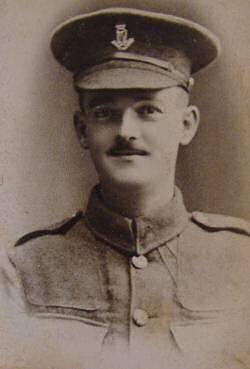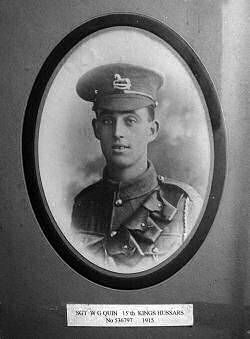According to the 1891 census
of Guernsey, the Quin family of the Longstore, St Peter
Port consisted of James H. Quin, a general labourer, his
wife Mary, and their children Flora, age 10, Ina, age 8,
Henry, age 4, and Reta, age 2. By 1901 the family had expanded
to include James, age 10, Lily age 6, William, age 4 and
Mabel age 2. Flora and Ina were no longer living at home
by this date, and there is no Henry (who would have been
14), but instead there is a son, Herbert, age 14. Harry
is now described as a stone quarryman, and the family are
living in Barker's Lane, St Sampson.
|
|

James William Quin
|
At the outbreak of war, James William, now age 23, joined
the 6th Btn Royal Irish Regiment, along with many other
Guernseymen, and is listed as 3320 Private James Quinn.
The spelling variation was adopted by some family members
at about this time, according to Deputy Francis Quin,
nephew of James.
|
The 16th (Irish) Division was composed of the 8th and
9th Royal Dublin Fusiliers, 6th Royal Irish Regiment,
6th Connaught Rangers, 7th Leinster Regiment, 8th and
9th Royal Munster Fusiliers, 7th Royal Irish Rifles, 7th
and 8th Royal Inniskilling Fusiliers and 7th and 8th Royal
Irish Fusiliers.
The British army's 16th "Irish" Division was
raised September 11, 1914, part of the second wave of
Field Marshal Kitchener's volunteer "New Army"
divisions designed to augment Britain's six professional
divisions. After completing training in England, the division
sailed to France in December 1915, and suffered great
losses in April 1916, at Hulluch, where the Germans unleashed
one of the most concentrated gas attacks of the war. Although
the Irish troops repulsed the enemy, the Division suffered
1,980 casualties, of whom 1,260 were the victims of gas.
James
William Quinn was killed in action on 15 April 1916
and is buried at Bois-Carré Military cemetery,
Pas de Calais. He left a widow and two children.
|
|
The Hussars formed part of the Cavalry Division, one
of the first Divisions to move to France. They remained
on the Western Front throughout the war, taking part in
most of the major actions where cavalry were used as a
mounted mobile force, and also many others where the troops
were dismounted and effectively served as infantry.
William George Quinn survived the war and went into the
Reserve on 1 January 1921.
|
536797 Corporal William George Quinn joined
the15th King's Hussars, and is pictured here in 1915
when he was a sergeant.
|

William George Quinn
|